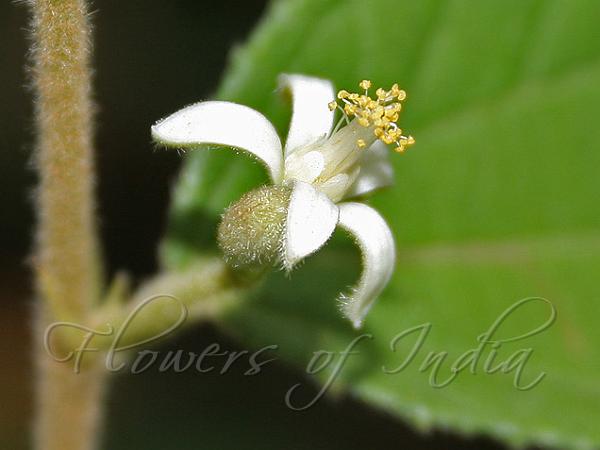|
| Nagbala Crossberry |
|

|

| File size | 93117 |
| Original date | 8/15/08 5:31 PM |
| Resolution | 636 x 477 |
| Flash | Flash fired, red-eye reduction |
| Focal length | 55.0mm |
| Exposure time | 1/60s |
| Aperture | 5.6 |
| Focus Distance | |
| Metering Mode | Multi-segment |
| Camera make | Canon |
| Camera model | Canon EOS 350D DIGITAL |
| Sensor type |
|
|
|
|
Photo: |
Botanical name: Grewia hirsuta Family: Tiliaceae (Falsa family)
Synonyms: Grewia obliqua, Grewia pilosa, Grewia roxburghii
Synonyms: Grewia obliqua, Grewia pilosa, Grewia roxburghii
Nagbala Crossberry is a shrub or small trees, with branchlets coarsely gray-brown
hairy. Leaf stalks are 2-3 mm long, tomentose. Leaves are lance-shaped,
6-14 cm long, 2-3.5 cm wide, leathery, black-brown when dried, velvety.
Lateral basal veins are up to 1/2 as long as leaf blade, lateral veins 4-5
pairs, base narrow, shallowly hreat-shaped, margin toothed, tip long
pointed or rarely blunt. White flowers are borne in cymes 1-5 per leaf
axil, 3- or 4-flowered. Stalk of the cyme is 3-7 mm, velvety. Flower stalk
is 3-5 mm, velvety. Bracts are lance-shaped, 3-4 mm. Sepals are narrowly
lance-shaped, 6-7 × 1.5 mm. Petals are narrowly ovate, about 3 × 1.5 mm.
Stamens are 4-5 mm. Style is longer than stamens, stigma 4-lobed. Drupe is
globose or 2-lobed, sparsely coarsely hairy; drupelets 2 per lobe.
Flowering: June-July.
Medicinal uses: Nagbala, as it is called in Ayurvedic lingo, is
used for heart disease, cough, wounds and dyspnoea (root); in diarrhoea
and dysentery (drupes); heart disease, fever (plant).
Nagbala, as it is called in Ayurvedic lingo, is
used for heart disease, cough, wounds and dyspnoea (root); in diarrhoea
and dysentery (drupes); heart disease, fever (plant).
Medicinal uses:
 Nagbala, as it is called in Ayurvedic lingo, is
used for heart disease, cough, wounds and dyspnoea (root); in diarrhoea
and dysentery (drupes); heart disease, fever (plant).
Nagbala, as it is called in Ayurvedic lingo, is
used for heart disease, cough, wounds and dyspnoea (root); in diarrhoea
and dysentery (drupes); heart disease, fever (plant). | Identification credit: Shrikant Ingalhalikar | Photographed in Talakona forest, Andhra Pradesh. |
• Is this flower misidentified? If yes,